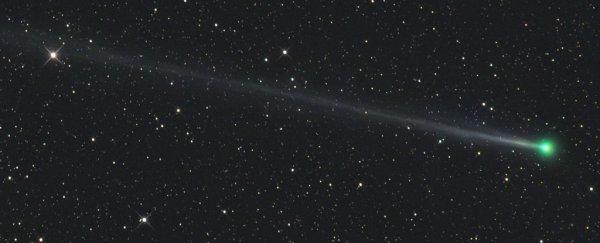A bright green comet will be passing close enough to Earth this weekend for skywatchers to see it using binoculars or a telescope.
Comet 45P will come closest to Earth in the early hours of Saturday, 11 February, when it passes Earth at a distance of around 12.4 million kilometres (7.7 million miles) - roughly 30 times the distance between Earth and the Moon.
If it's cloudy where you are (or you don't want to tear yourself out of bed), you can also watch the whole thing from the comfort of your computer via Slooh, starting shortly:
But the awesome events don't end with the comet. Depending on where you are in the world, you might also be lucky enough to see a weak type of lunar eclipse shadowing the full moon, known as a penumbral eclipse.
To understand what that is, you first need to know that there are two shadows cast by the Earth during a lunar eclipse.
First, there's the umbra, which is the dark centre of the eclipse shadow where the Moon is completely in the shadow of the Earth.
Then there's the penumbra, which gets larger the further it gets from Earth. It's a weaker shadow caused by the Earth covering a portion of the Sun.
 NASA
NASA
A penumbral eclipse occurs when only this penumbral shadow falls across the Moon's surface - making it pretty subtle and hard to observe.
You may notice a dark shadow on the Moon, or simply see the Moon looking a little darker than usual, as you can see in NASA's gif below.
 NASA
NASA
Due to timing, the lunar eclipse is only really visible in the Northern Hemisphere - and for most of the US it'll only be visible during Moon rise. Those in Africa and most of Europe should be able to see the whole thing.
You can see a map of the eclipse's visibility below:
 NASA
NASA
And the scheduled start times in the US:

Although the full moon makes sky-gazing a little more exciting on Friday night, it'll also make it harder to spot Comet 45P.
It'll be at its closest to Earth at around 3.30am EST (7.30pm AEST) 11 February, and to get the best chance of viewing it, head out somewhere dark, give your eyes plenty of time to adjust, and use binoculars or a telescope to look towards the constellation Hercules in the Northern Hemisphere.
If you're in the Southern Hemisphere, look towards the north-eastern horizon about an hour and a half before dawn on the morning of Sunday 12 February.
Wherever you are, it should look like a fuzzy green ball making its way across the sky.
The brightness of the full moon will make it harder to spot Comet 45P tonight, but even if you miss its closest pass, NASA says it should still be bright enough to spot with binoculars over the next few evenings (or mornings, depending on where you are in the world).
And if all else fails, you can watch it form the comfort of bed via Slooh:
And you can watch online coverage of the penumbral eclipse, too:
Comet 45P comes past Earth roughly every five to six years, but this weekend's encounter will be the closest until the end of this century - the comet will pass our planet again in 2032, but at a distance of 48 million kilometres (30 million miles).
It'll also be the first of a trio of comets that NASA is hoping will reveal some important clues about the types of comets that exist in our Solar System - allowing them to put together a 'comet family tree'.
They'll be looking closely at Comet 45P as it approaches, and studying the gases, dust, and ice particles in its tail - and it's particularly useful seeing as we know it's going to pass by us again so soon.
"Observing a comet multiple times over successive orbits is like taking snapshots at different stages of life," said Joseph Nuth, a senior scientist at NASA's Goddard Space Flight Centre.
"And some comets have harder lives than others, depending on how close they get to the sun. We can learn about these effects by comparing different comets with varying perihelion distances over time."
NASA scientists will also observe Comet 41P/Tuttle-Giacobini-Kresak, which will pass closest to Earth on 1 April 2017, and Comet 46P/Wirtanen, which will zoom past us on 16 December 2018.
All of these should be visible with binoculars.
"Comet 46P in particular will remain within 10 million miles of Earth for several weeks, from December 4 through 28, 2018," said NASA researcher Michael DiSanti.
"This will permit detailed studies of its material, as successive regions of the comet's nucleus become exposed to sunlight."
Happy star gazing!
